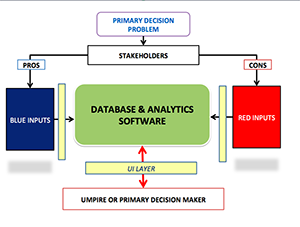|
Can Wargaming tools aid the Military Decision Maker in the uncertain future?
(Web Article Serial 2)
In the first web article published on 06 Dec 16 in the CLAWS website, the author has contended that the future is likely to see the emergence of numerous Black Swan events. The metaphor “Black Swan Event” was made popular by author and former derivatives trader Nassim Nicholas Taleb, which refers to unpredictable and uncertain events. Uncertainty will emerge as the new normal and decision making challenges will be immense especially for strategic military leaders. In this context, wargaming tools may help in reducing the randomness of the future and offer an alternate decision making aid.
Challenges to Future Military Decision Making at the Strategic Level
Military decision making at the strategic level was always a challenge, however the increasing disorder and uncertainly in the future world will add to the difficulty manifold. A decision maker in business or industry can swiftly adapt to changes in the environment. The subordinates and the organisation will do likewise. Any decision can be justified in context of its financial relevance. However in the military, as in politics, decision making is a well entrenched process and the leader is perpetually under scrutiny, both internally and externally, well into the future. It would be prudent to highlight certain peculiarities of the traditional military decision making process, which may be further strained and affected due to increasing uncertainty.
- Collaboration in Military Decision Making. Military decisions are by the very nature, a reflection of the Commander and his/her personality. Military history shows us that attribution of success or failure in war sits squarely on the shoulder of the leader and the decisions taken by him/her. Seldom has the result been seen as a function of the staff or subordinate organizations. Military leaders take pride in their decision making ability and invariably take ownership of the same. It is in this context, the first challenge emerges. Military leaders desist being seen as overtly collaborative in their decision making process. Excessive collaboration could also be construed as a sign of a hesitant and weak leader which could affect the morale of the command. The role of the staff and other stakeholders is purely advisory in nature and the onus of the final decision is purely on the leader – a singular entity. The contrast emerges distinctly when we analyse decision making in the corporate sector, where often the contentious decisions are collectively attributable to Boards/Trusts etc. However future military decisions are likely to be taken in the backdrop of extreme uncertainty and inputs from all valid stakeholders will be a prerequisite to achieve precision. The multi stakeholder approach may be the need of the hour. The challenge is to accommodate multi stakeholder views without compromising the singularity of a military decision.
- Stake of Decisions. Military decisions are routinely taken in the shadow of paramount issues like life, death, national security etc. The stakes are invariably huge and ramifications of an incorrect decision can be adversely felt, well into the future. The psychological impact of these critical decisions on the leader is immense. The future is likely to throw up far greater psychosomatic challenges to the military leader.
- Data driven Decisions. Military decisions at the strategic level are seldom purely data driven. This is because discrete data cannot possibly be captured for the huge variety of situations that the military functioning offers. Hence data driven, computer aided decision making has never really been adopted especially at the strategic level. However in future, data mining and data analytics will invariably play a part in policy formulation and decision making. The challenge lies in making military decisions more data driven, while at the same time not being constrained due to lack of data.
- Risk vs Returns. An integral part of military decision making is the element of risk. Military history has proven time and again that an audacious leader with an element of risk has achieved success much beyond a sum of the capabilities. Nations, governments and militaries have rallied behind risk taking military leaders on number of occasions. However the future may see greater risk aversion within the polity and the population. Hence the emerging conflicts may see military leaders encounter a peculiar challenge – the freedom of taking an audacious military decision with a fair element of risk may reduce, especially in conflicts in the lower end of the conflict spectrum.
Summarizing the arguments in the foregoing paragraphs, it can be postulated that the nature of military decision making at the strategic level in an increasingly uncertain world of tomorrow, will be a new challenge. Military leaders at the highest level will be constrained and will surely require some well tested aids which can aid decision making.
Why Wargaming?
It is in this back drop that we may give a fresh look to the age old art of wargaming. Wargaming has evolved over times and has been used extensively as a training and planning tool in the military. It has also been used as a platform to test the basic decision making ability of junior and mid level officers. In the Indian Army, this has been used for tactical leaders and for limited staff at operational level. Wargaming has seldom addressed the need for strategic leaders. Here wargaming should be seen in contrast to the process of “Brainstorming” and “Validation” that field formations in the Indian Army are more used to. The basic wargaming model has the element of opposition at every stage of the game, certain structured rules and a result. Wargaming offers certain advantages which may be adopted in a decision aid model. It would be prudent to examine these aspects in the context of challenges to strategic military decisions as enumerated earlier.
- Wargaming, by its very nature imitates uncertainty. The process generates situations which are neither comfortable to the players nor planned for, since the opponents are perpetually trying to outdo each other in the cognitive plane. Hence it is likely to throw up a large number of unique situations which real life or training exercises may never throw up. A wargame can arguably bring us closer to the range of possibilities which the uncertain future is likely to throw up.
- Wargaming accommodates diverse views and opinions. Current decision making philosophy in the armed forces works on different stakeholders projecting their viewpoint to the decision maker, who acts as the central adjudicator. Seldom is one viewpoint of a stakeholder pitted against a counter viewpoint of another stakeholder. Wargaming offers this multi stakeholder approach where the leader can bring in more objectivity to his/her decisions by going through the process.
- In real life, the effect of a small, insignificant incident may blow out of proportion and overshadow all other factors. This aspect may be glossed over in the traditional decision making process, since by very nature, intuition tends to disregard insignificant aspects as clutter. Wargaming offers the facility to highlight even small insignificant events and calls for the reactions of the players to these events too.
- A Wargame penalizes a delayed decision. The effect of the penalty imposed is evident on game result. This aspect may tend to get neglected in traditional decision making process as effects due to a delayed or hesitant decision is seldom quantifiable or immediately evident.
- A Wargame can be played on the same setting more than once, however the results may be different each time. A Wargame adds to the experience of the players. More critically it adds to the experience and knowledge of the observer(s) of the wargame process. The gain in experience is based on the theory of constructivism. Jean Piaget, known for his views on the theory of constructivism wrote on how humans make meaning out of real world situations by constant interaction between their ideas and experiences. This interaction ultimately leads to decisions.
- Wargames are governed by rule sets which are mathematical. Results in a wargame, are dependent on data generated due to decisions taken during the game process. Hence wargames bring in an element of objectivity in the decision making process and supports data driven decision making.
Proponents of external decision making aids tend to tilt towards data driven and computerized models which attempt to increase the quantitative factor over the qualitative. However in strategic military decisions, this approach has a major deficiency wherein the correctness of the rule set or algorithm is always subject to scrutiny and introspection. The challenge for future military leaders is to strike a right balance between intuition and data/information driven decisions, which in a way brings us to the age old predicament as to whether military studies is an art or a science. It is commonly accepted in modern times that military studies is both an art and a science. The US Army Command and Staff College even runs a masters programme on Military Arts and Science (MMAS). In the Indian Army Defence Services Staff College (DSSC), wargame decisions are analysed through the prism of the Military Decision Making Process(MDMP), an analytical tool. It is in this context that Wargaming tools may be studied which arguably offers an avenue to achieve a rational mix of intuition and information/data driven decisions or of art and science. The proposed model is based on a mix of wargaming tools and Operational Research(OR) methodology. OR is a management discipline that deals with the application of advanced analytical methods to help make better decisions. It use started off in the military field during World War II, where it was mainly used to find optimized solutions to technology related questions. However, presently its use is more prevalent in the industry and business sector. The aim of using OR in the proposed model is to bring in an element of data driven objectivity, without overwhelming the intuitive decisions of a military leader which is based on experience, critical thinking and logical reasoning.
The Proposed Framework

The aim of the proposed model is to provide all possible inputs; positive, negative and neutral in a structured and quick timeframe to the primary decision maker. The primary decision maker when confronted with two contrary view points, accords a higher numerical value to the aspect which he/she feels is more relevant. During this process, the primary decision maker is not exposed to the numerical value assigned to the same factor by the stakeholder(s). The background algorithm will give a greater importance to factors which have been given maximum weightage by both the stakeholder and the primary decision maker. The end result will be a cumulative of all inputs and the values assigned to them, which are thrown in a random manner to the primary decision maker.
(In serial three of the Web Articles on the subject, the author will elucidate the proposed model)
|



